Food profiling by high resolution 1H-NMR analysis
Food profiling by high resolution 1H-NMR analysis
Food profiling by high resolution 1H-NMR analysis
You also want an ePaper? Increase the reach of your titles
YUMPU automatically turns print PDFs into web optimized ePapers that Google loves.
N° 33 - July 2010<br />
<strong>Food</strong> <strong>profiling</strong> <strong>by</strong> <strong>high</strong> <strong>resolution</strong> 1 H-<strong>NMR</strong><br />
<strong>analysis</strong><br />
New frontier of authenticity testing<br />
By Dr. Eric Jamin, Eurofins Scientific Analytics, France<br />
A common request from quality control<br />
managers in the food industry is to have<br />
available a screening method that will not only<br />
monitor products or their ingredients for known<br />
hazards, but also detect whether a product<br />
has an unusual profile or contains atypical<br />
components, at an early stage of production.<br />
Fingerprinting using <strong>1H</strong>-<strong>NMR</strong> (proton nuclear<br />
magnetic resonance spectroscopy) may<br />
provide the solution: it is fast (just a few<br />
minutes needed with little sample preparation)<br />
and it is widely applicable as every hydrogen<br />
containing molecule present in the sample will<br />
generate a specific signal.<br />
By comparing the resulting spectrum with a<br />
database of reference values the technique<br />
allows for a rapid quantification of a wide range<br />
of known components in a product, with a<br />
precision comparable to chromatography for<br />
example. It can also detect the presence of<br />
atypical components, which can be tentatively<br />
identified from the <strong>NMR</strong> signal. This makes<br />
<strong>NMR</strong> <strong>profiling</strong> an ideal screening method for<br />
the purpose of preventing food crises such as<br />
that posed <strong>by</strong> melamine.<br />
Eurofins is routinely applying this technique on<br />
fruit juices and has succesfully established its<br />
potential on spices, oils and milk. On request,<br />
the technique can be adapted to liquid and<br />
solid samples of all kind of food. Spectral<br />
fingerprints can also be used to perform<br />
traceability checks on finished food products<br />
and ingredients within a “global control”<br />
scheme applied to the entire supply chain.<br />
Since the analytical cost decreases rapidly<br />
with <strong>high</strong> sample numbers, <strong>1H</strong>-<strong>NMR</strong> <strong>profiling</strong><br />
is particulary suited to the routine screening<br />
of large series of samples. In case of spectral<br />
discrepancies, the sample can then be further<br />
analysed <strong>by</strong> focusing test methods that target<br />
the specific compound or group of compounds.<br />
It is therefore also a cost effective screening<br />
method for monitoring product authenticity.<br />
Contact: ericjamin@eurofins.com<br />
Example application of <strong>profiling</strong> <strong>by</strong> HR- 1 H-<strong>NMR</strong><br />
www.eurofins.com
<strong>Food</strong> allergens in the focus<br />
By Dr. Carmen Diaz-Amigo and Dr. Bert Pöpping, Eurofins, Germany<br />
The introduction of maximum threshold<br />
and action levels for food allergens<br />
has been intensely debated across<br />
countries that have allergen labelling<br />
regulations. The intention is that these<br />
thresholds will help industry to protect<br />
their customers, and regulators to<br />
enforce legislation. Eurofins’ scientists<br />
have authored and co-authored two<br />
publications in the reputable, peerreviewed<br />
Journal of AOAC International.<br />
The paper <strong>by</strong> Dr. Carmen Diaz-Amigo<br />
and Dr. Bert Pöpping discusses the<br />
introduction of thresholds or action<br />
levels for allergen labelling and it<br />
clearly shows the benefits and limits of<br />
existing and emerging test methods.<br />
Furthermore, the authors suggest how<br />
industry, despite some variability and<br />
uncertainty in methods, can make<br />
meaningful risk-management decisions<br />
based on analytical results, and how<br />
regulators can approach the formulation<br />
of wording within legislation regarding<br />
action levels.<br />
The second publication (Abbott et<br />
al.) covers validation guidelines for<br />
food allergen ELISA assays. It is a<br />
milestone in harmonising how validation<br />
is conducted. It summarises the<br />
outcome of intensive work <strong>by</strong> experts<br />
worldwide over the last three years.<br />
The guidance provided will lead to more<br />
robust, reliable and cohesive analytical<br />
results, allowing industry to integrate<br />
analytical testing as a valid tool into<br />
the allergen control risk-management<br />
decision processes. It will also enable<br />
better food enforcement <strong>by</strong> government.<br />
This publication is co-authored <strong>by</strong> Dr.<br />
Bert Pöpping as well as other experts<br />
from Health Canada, the European<br />
Commission, the Australian National<br />
Measurements Institute, Nestlé<br />
Determination of endosulfan in soybeans<br />
By Johannes Jaschik, Eurofins Dr. Specht Laboratorien GmbH, Germany<br />
Endosulfan is a persistent<br />
organochlorine insecticide which was<br />
banned in Europe a long time ago.<br />
However, in some parts of the world<br />
this pesticide is still available and in<br />
use. Due to the nature of endosulfan<br />
it accumulates in foods which have a<br />
<strong>high</strong> fat content such as peanuts or<br />
soybeans. One of the most important<br />
exporters of soybeans is Brazil, and the<br />
content of endosulfan in conventional<br />
and even organic Brazilian soybeans is<br />
a common problem.<br />
In order to protect consumers, ensure<br />
brand confidence and for quality<br />
assurance purposes it is necessary<br />
to analyse soybeans for pesticide<br />
residues. As the final decision about<br />
shipments of Brazilian soybeans often<br />
depends on the result of pesticide<br />
residue <strong>analysis</strong>, it is important to<br />
have a reliable and sensitive method.<br />
Therefore, the method has to be able to<br />
determine the endosulfan isomers and<br />
its metabolite endosulfan sulphate.<br />
Almost all laboratories that perform<br />
pesticide residue <strong>analysis</strong> offer the<br />
determination of endosulfan. However,<br />
in order to achieve a reliable result in<br />
soybeans, the <strong>high</strong>er fat content of the<br />
product and the non polar properties<br />
of the endosulfan compounds has to<br />
be taken into account. Therefore, a<br />
combination of extraction method using<br />
non polar solvents (e.g. the worldwide<br />
recognized DFG-S19 method) and a<br />
detection with GC-system should be<br />
applied. Recent studies confirm that<br />
detection with the commonly used<br />
GC-MSD using the EI (Electron Impact)<br />
ionization mode is less suited to the<br />
detection of endosulfan at the required<br />
levels. A far better option is to use the<br />
long established GC-ECD procedure<br />
which allows detection at levels far<br />
below 10 ppb.<br />
Eurofins offers a routine<br />
chromatographic method using<br />
GC-ECD detection for determination<br />
of endosulfan. This is the most<br />
sensitive and reliable technique for the<br />
determination of this pesticide at trace<br />
Nutrition, FARRP and ICC.<br />
Eurofins is therefore not only directly<br />
helping its clients with the <strong>analysis</strong> and<br />
interpretation of results, but also actively<br />
engaged with industry and legislators<br />
to help drive forward the development<br />
of appropriate technical innovation<br />
and modern risk evaluation tools for<br />
the ultimate benefit of the consumer.<br />
This is a consequence of the scientific<br />
expertise and experience to be found<br />
within the Group and the recognition of<br />
this status <strong>by</strong> participation on panels<br />
like the AOAC. By contributing towards<br />
the cutting edge of development and<br />
information at the international level,<br />
Eurofins is a market-leader in translating<br />
this expertise into the <strong>high</strong>est-quality<br />
results for its clients.<br />
Contacts: carmendiaz@eurofins.com,<br />
bertpopping@eurofins.com<br />
levels in products with <strong>high</strong> fat levels<br />
that are more difficult to analyse.<br />
Contact: spechtasm@eurofins.de
Implication of new GM-Rice varieties for food and feed<br />
production<br />
By Nicholas Krohn, Eurofins GeneScan, Germany<br />
Genetically modified (GM) plants have<br />
been developed and commercialised<br />
for crops such as soy, corn, canola<br />
and cotton in the past years. Increased<br />
efforts are being invested into the<br />
development of GM rice<br />
varieties, the staple food<br />
in much of Asia. Among<br />
the countries developing<br />
biotechnologically enhanced<br />
rice, China is taking a leading<br />
role.<br />
Although no large scale<br />
production of GM rice is taking<br />
place, notifications on GM<br />
rice are listed in the European<br />
Rapid Alert System for <strong>Food</strong><br />
and Feed (RASFF) since 2006.<br />
The GM rice line called ‘Bt63’<br />
has been detected in several<br />
products originating from<br />
China - which is why all rice<br />
imports from China have to<br />
be analysed for the presence of ‘Bt63’<br />
(commission decision 2008/289/EC).<br />
Apart from ‘Bt63’ other rice varieties are<br />
known to be in development such as<br />
‘Kemingdao’ (KMD1) and ‘KeFeng6’.<br />
The latter GM variety, ‘KeFeng6’, was<br />
presumably detected and notified in the<br />
RASFF recently.<br />
Analytical strategies for the detection of<br />
GM rice have to be designed to ensure<br />
detection of the above mentioned<br />
varieties as none of them are approved<br />
for use in food and feed. Testing for<br />
‘Bt63’ according to the community<br />
reference laboratory (CRL) method only,<br />
would comply with the EU Commission<br />
Decision, but would not detect these<br />
other GM rice varieties.<br />
Eurofins offers a complete analytical<br />
portfolio for the detection of GM rice<br />
varieties. Besides testing for ‘Bt63’ using<br />
the CRL method, newly developed<br />
methods enable the detection of ‘KMD1’<br />
and ‘KeFeng6’. Historically Eurofins<br />
leading competence in the<br />
area of GM testing ensures fast<br />
reaction times when it comes<br />
to the development of new<br />
GM testing methods for our<br />
customers.<br />
Contact:<br />
gmoanalytics@eurofins.com<br />
Hexanal - a parameter for the assessment of spiced oils<br />
By Nadja Liebmann and Dr. Torben Küchler, Eurofins Analytik GmbH – Wiertz-Eggert-Jörissen, Germany<br />
Spiced oils in the market are enjoying<br />
an increasing popularity. They are<br />
produced from native or refined<br />
oils, where herbs, spices and other<br />
flavouring ingredients are added. To<br />
assess the quality of such spiced<br />
oils, similar criteria as for edible oils<br />
are recognized. For pure oils the<br />
oxidation status can be identified<br />
through the absence of certain sensory<br />
characteristics (e.g. no rancid attributes)<br />
and chemical parameters (e.g. peroxide<br />
value and anisidine value).<br />
With regard to these parameters the<br />
following problems can occur: the<br />
detection threshold for sensory tests is<br />
raised because the flavour components<br />
from the ingredients cause an additional<br />
strong smell and taste in the product.<br />
Similarly, colourful ingredients can bias<br />
the result for the anisidine value.<br />
For these products, other parameters<br />
that give information about the oxidation<br />
state of the spiced oil are needed.<br />
Hexanal is a secondary fat oxidation<br />
product and is described as a marker<br />
for the beginning of spoilage in the<br />
scientific literature. However, in virgin<br />
olive oil hexanal is also present as a<br />
component of the typical aroma. An<br />
authoritative limit is not given for the<br />
hexanal content, but a German nongovernmental<br />
organisation used this<br />
parameter for assessing oils and spiced<br />
oils in the past.<br />
Recently, Eurofins Analytik established<br />
a new test method for the determination<br />
of hexanal. The volatile compounds<br />
from the oil are concentrated using<br />
a dynamic headspace technique on<br />
an adsorbent material, separated via<br />
gas chromatography and determined<br />
<strong>by</strong> mass spectrometry. This modern<br />
method allows the determination of<br />
hexanal content down to 10 µg/kg.<br />
Contacts: nadjaliebmann@eurofins.de<br />
(responsible ASM),<br />
torbenkuechler@eurofins.de (R&D<br />
Department)
in brief<br />
European Union<br />
consolidates plastic<br />
legislation<br />
The European Commission is working<br />
on a consolidation of the Regulations<br />
concerning packaging and articles<br />
that come into contact with food,<br />
which are made from plastics. At the<br />
moment plastic materials are covered<br />
<strong>by</strong> the Plastic Directive 2002/72/EC<br />
which has already been amended 6<br />
times. Additionally, there are several<br />
Directives and Regulations dealing with<br />
test conditions for plastics intended as<br />
food contact material.<br />
Certain changes in test conditions such<br />
as time, temperature profiles and the<br />
food simulants to be used are under<br />
discussion. The Regulation is expected<br />
to be released during this year and, in<br />
contrast to the current Directives, it will<br />
come into force in all European States<br />
20 days after publication without the<br />
need for adoption into national law.<br />
Contact: andreasgrabitz@eurofins.de<br />
Nanotechnology - Opening<br />
Pandora’s box?<br />
Nanotechnology is the science of<br />
very small particles (10-9m) which<br />
often fundamentally change their<br />
properties at this size. The most well<br />
known example is the Lotus effect on<br />
cars from nanocoatings. However,<br />
nanotechnology has long found its<br />
way into packaging materials and<br />
food e.g. as anti-caking agent (SiO ). 2<br />
BUND (Friends of the Earth) estimated<br />
that more than 90 nanomaterials are<br />
already used in more than 600 foods.<br />
This raises questions such as: Do the<br />
products containing nanomaterials<br />
Eurofins China<br />
Peter Leedham / peterleedham@eurofins.cn<br />
Eurofins Denmark<br />
Svend Aage Linde / sal@eurofins.dk<br />
Eurofins France<br />
François Vigneau / francoisvigneau@eurofins.com<br />
Eurofins Germany<br />
Tanja Trampe / service@eurofins.de<br />
Eurofins Italy<br />
Valeria Merlo / valeriamerlo@eurofins.com<br />
Eurofins Japan<br />
Colin Granier / colingranier@eurofins.com<br />
need to be labelled? Are they safe?<br />
How does one recognise foods<br />
containing them? Is existing legislation<br />
sufficient to protect consumers but<br />
still able to allow the utilisation of the<br />
benefits of this technology?<br />
At the recent International<br />
Nanotechnology Conference organised<br />
<strong>by</strong> Eurofins CTC in Hamburg with<br />
speakers from RIKILT, European<br />
Commission JRC, FERA, BfR ,<br />
BLL, BUND and DLG, the issues<br />
surrounding its safe use, acceptance,<br />
and existing and forthcoming<br />
regulations were discussed.<br />
At this well attended conference, the<br />
participants from a wide range of<br />
industry sectors as well as consumer<br />
organisations, actively engaged in<br />
the debate and discussion. After<br />
the success of this nanotechnology<br />
conference, follow-up events will be<br />
organised.<br />
Contact: conferences@eurofins.com<br />
New multi method for the<br />
determination of veterinary<br />
drug residues in meat and<br />
fish<br />
Eurofins WEJ Contaminants<br />
developed a new multi-class, multianalyte<br />
method for the simultaneous<br />
determination of about 90 veterinary<br />
drug residues (Benzimidazoles,<br />
Quinolones, Nitromidazoles,<br />
β-Lactams, Macrolides,<br />
Triphenylmethane Dyes, Avermectins,<br />
Sulphonamides and Tetracyclines) in<br />
meat and fish.<br />
The method based on liquid<br />
chromatography-tandem mass<br />
spectrometry with electrospray<br />
Eurofins Netherlands<br />
Linda Tilman / l.tilman@eurofins.nl<br />
Eurofins Norway<br />
Inger Johanne Bakke / inb@matanalyse.no<br />
Eurofins Sweden<br />
Stig-Olof Lundin / stig-oloflundin@eurofins.se<br />
Eurofins Switzerland<br />
Klaus Fuchs / klausfuchs@eurofins.com<br />
Eurofins UK<br />
Liz Paterson / info@eurofins.co.uk<br />
Eurofins USA<br />
Lars Reimann / larsreimann@eurofinsus.com<br />
ionization (LC-MS/MS) has proved to<br />
be robust and time-saving due to the<br />
simple and rapid sample preparation.<br />
Full compliance with the Maximum<br />
Residue Limits (MRLs) defined <strong>by</strong><br />
the Commission Regulation (EU) Nr.<br />
37/2010 will be achieved for most of<br />
the analytes.<br />
Contact: carinabartz@eurofins.de<br />
Monitoring of<br />
perfluoroalkylated<br />
substances in food<br />
The European Commission<br />
recommended the monitoring of<br />
perfluoroalkylated substances<br />
(perfluorinated compounds - PFCs)<br />
in food of plant or animal origin, such<br />
as fish, meat, eggs, milk and derived<br />
products, to enable an accurate<br />
estimation of exposure.<br />
Especially Perfluorooctane sulfonate<br />
(PFOS), perfluorooctanoic acid<br />
(PFOA), their precursors and<br />
polyfluoroalkyl phosphate surfactants<br />
(PAPS) in particular need to be<br />
monitored to estimate the relevance of<br />
their presence in food.<br />
Eurofins GfA Competence Centre for<br />
dioxins & persistent organic pollutants,<br />
offers the <strong>analysis</strong> of PFCs in food. At<br />
present more than 25 fluorinated and<br />
partially fluorinated compounds can be<br />
determined. All methods are regularly<br />
reviewed to extend the parameter list<br />
in accordance to EC-Recommendation<br />
2010/161/EC from 17th March 2010.<br />
Contact: michaelalichte@eurofins.de<br />
Other countries<br />
info@eurofins.com<br />
Newsletter editorial team:<br />
F. Heupel, L. Kandalaft , S. Noster-Vallée, B. McLean,<br />
M. Langmaak, T. Trampe, L. Reimann, S. Jensen,<br />
S. van Tellingen, M. Martin.<br />
Design: Romain Soussan<br />
© Published <strong>by</strong> Eurofins Scientific.<br />
All rights reserved. The greatest care has been<br />
taken to ensure accuracy but the publishers cannot<br />
accept any legal responsibility or liability for errors or<br />
omissions that may be made.<br />
For further information & contacts in<br />
other countries please refer to our<br />
website www.eurofins.com


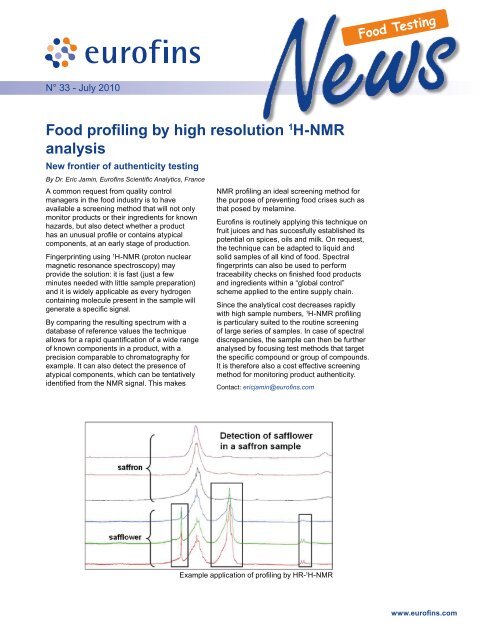
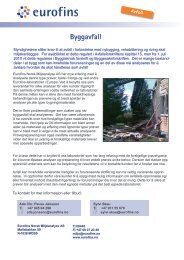
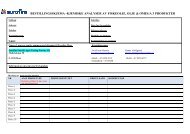

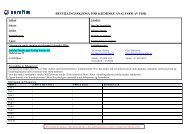
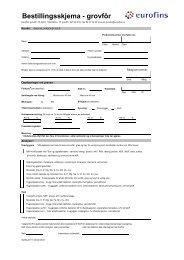
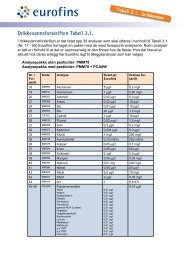
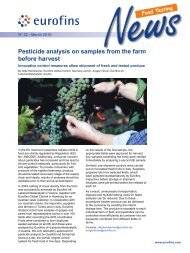
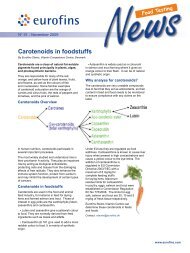
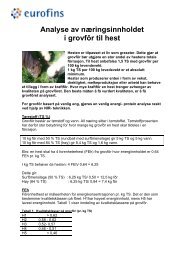
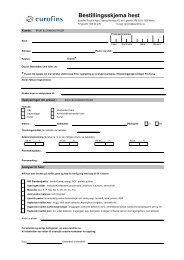


![Generelle salgsbetingelser [PDF 160 Kb] - Eurofins](https://img.yumpu.com/18261898/1/184x260/generelle-salgsbetingelser-pdf-160-kb-eurofins.jpg?quality=85)